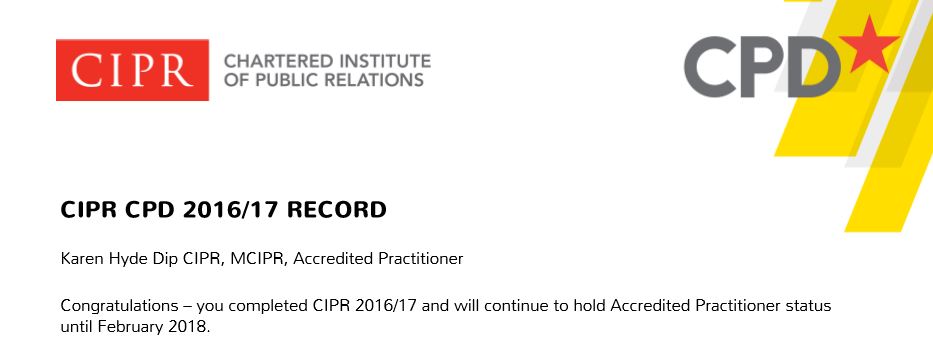Showing your commitment to a continued professional development (CPD) programme could make all the difference.
For self-employed and freelancers especially, your training evidence or CPD record is proof of your knowledge and capability. It shows your skills are up to date, you follow best practice and have high ethical standards.
And because we are our own employers, it’s unlikely we’ll ever have a formal performance review as we used to in the workplace.
The time I’ve invested in maintaining my CPD has paid off. Customers say one of the reasons they chose to work with me is because I adhere to an industry-recognised code of conduct and follow a learning and development training programme.
 Keeping my CPD up to date means I’ll maintain my status of CIPR Accredited Practitioner for another year. I’m proud to have held this for over 10 years but if I was to miss one CPD cycle, I’d lose it and it would take three years of CPD to get it back. That keeps me going too.
Keeping my CPD up to date means I’ll maintain my status of CIPR Accredited Practitioner for another year. I’m proud to have held this for over 10 years but if I was to miss one CPD cycle, I’d lose it and it would take three years of CPD to get it back. That keeps me going too.
Taking advantage of the Summer for CPD
This year, I’ll be doing some extra studying over the summer and the longer evenings really help. Also, I thought it would give me an extra incentive if I made my goals public so here goes:
My CPD Goals for 2017-2018
Professional Development
- Writing and editing
- Branding and reputation
- Visual content and video
Compulsory
- Ethics: As a CIPR member I am accountable to the Code of Conduct and are expected to demonstrate technical, strategic and ethical competence.
I use the CIPR’s huge bank of online learning resources, which includes reading, case studies, skill guides, webinars, full and half-day training courses. I’m free to choose any activity and log it against my goal in my CPD record.
When the CPD year ends in February 2018, I’ll share my achievement record and you’ll see how I got on. If you’d like to see what last year’s report looks like, feel free to take a look:
 Click to view Karen’s full CPD Record 2016-2017
Click to view Karen’s full CPD Record 2016-2017
“CPD is about developing your career adaptability. It’s how you build the knowledge and confidence to secure your professional future. It’s your investment in your biggest asset – you. And it’s part of your professional responsibility.”


